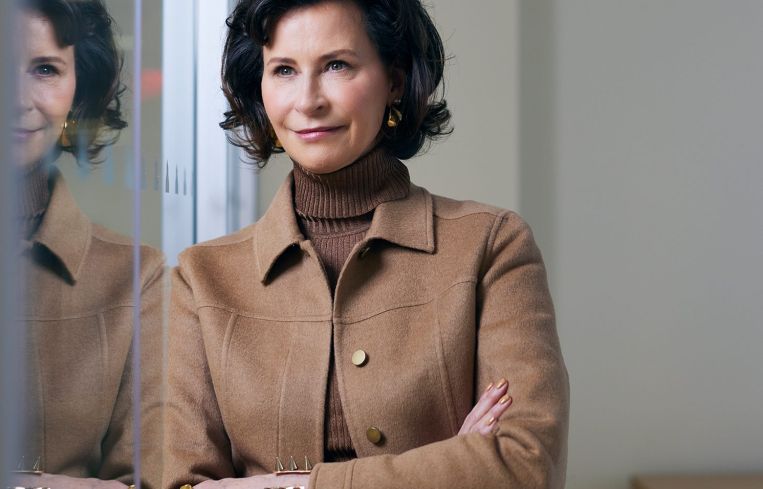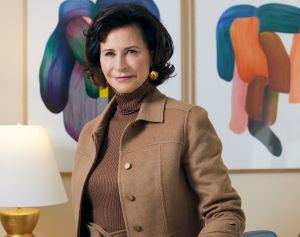Executive Orders: Michelle MacKay Is Leading Cushman Through a Challenging Market
By Cathy Cunningham March 12, 2024 2:40 pm
reprints
The commercial real estate industry has taken enough punches of late to leave it feeling like it’s just gone 10 rounds with Floyd Mayweather, and brokerages are no exception. Fourth-quarter earnings reports, weighed down by 18 months of beleaguered market conditions at that point, were lackluster across the board.
With market stabilization hopefully on the horizon, several of those firms are busy mapping out blueprints for their next chapters, leaning into growth areas and addressing any trouble spots.
One of those firms is Cushman & Wakefield.
At its helm is Michelle MacKay, who took the reins as CEO in July 2023. Seven months later, like every other head of a publicly traded company, MacKay addressed her company’s 2023 performance on its fourth-quarter earnings call: the good, the bad and the ugly.
Its $9.5 billion of revenue and $6.5 billion of service-line fee revenue decreased 6 percent and 10 percent, respectively, compared with 2022. Property management, facilities and project management grew 3 percent, but the company saw 12 percent annual declines in its leasing and valuation businesses, and a 41 percent decline in capital markets business revenues.
Outside of the call, the company has faced short selling of its stock, which hovered around $10 a share as Commercial Observer was going to press. In early 2023, the stock price was above $15 a share, and in 2022 it regularly topped $20. Meanwhile, some of the firm’s talent has jumped to rival brokerages, and Brookfield Properties in November dismissed C&W from handling the ownership giant’s office and logistics listings in the U.S.
It’s fair to say it’s been a baptism by fire for MacKay, who — despite the most arduous of market conditions — got straight down to business when she took over the CEO seat in July, starting with one big task up front.
Over the years, C&W was built via the acquisition of numerous companies. But since its initial public offering in 2018, leadership hadn’t stopped to take a holistic view on where the company stood, how the market had shifted, and what had been learned since. And with both a global pandemic and severe market dislocation impacting commercial real estate in a very real way in between, a full review was long overdue, MacKay said.
As such, Manhattan-based MacKay went on what she describes as “an immediate attack” to analyze all the underlying businesses and set up a strategy for them, all while continuing her daily duties as CEO.
The first week of August marked her first earnings call. The following week, C&W refinanced $1.4 billion of debt that was coming due in 2025. Then, MacKay pivoted to focusing on the strategy for the company going forward, which was approved at the beginning of November.
“My immediate focus was getting deep into the business, analyzing it, figuring out the areas that we could explode in — in terms of profitability and growth — and also considering which areas were non-core that we could walk away from,” she said, declining to name the latter areas out of a care for the employees who populate them.
MacKay describes her appointment as CEO as an “awakening and a change in philosophy” for the firm. She also brings a clear new mantra along with her that emphasizes her leadership style: “Better never settles.”
In simple terms, it equates to a quest to excel and both be, and provide, the very best. From offering bespoke, tailored solutions to clients; to thinking outside the box; to recruiting and retaining top, hungry talent; to leaning heavily on real-time data to advise clients — and, here’s the twist— honestly and without sugarcoating or agenda.
First, though, there are some things to address.
Earning her stripes
In tumultuous market conditions, only the most newsworthy nuggets tend to make headlines, occasionally turning into a public flogging when it comes to questions around a company’s health. MacKay spoke with Commercial Observer in late February, and wanted to set the story straight on a few misconceptions in the press regarding the health of C&W, a firm with 400 offices and 52,000 employees around the world.
Now in its 106th year, the company’s services run the gamut from global occupier services to tenant representation to debt and equity arranging (as CO was going to press, news broke of the firm being engaged by Meor to arrange $1.7 billion from U.S equity partners for an industrial development planned near the U.S.-Mexico border) but in a time dominated by capital markets upheaval, the magnifying glass often lingers there, instead of on the bigger, multifaceted picture.
“People are hyper-focused on capital markets, and we don’t end up having the conversation around the entire built environment or ecosystem,” MacKay said. “When we think about the world and providing real estate services, and, when we think about the future and where it’s going, we’re not thinking solely about capital markets and interest rates. We’re thinking about the ecosystem in a way that we facilitate our services, so that you wake up in an apartment building that we manage, and you go to a doctor’s appointment in a hospital that we clean, and you spend your day in office space that we may have leased to you and built out and done workplace solutioning for, and before you leave you order groceries from your favorite ecommerce app, and that food comes from a warehouse we’re managing.”
Why that’s important to conceptualize is because it’s not just speaking to one component of real estate, MacKay said. “It’s how we have built, and are going to continue to build, our business.”
Not that a hyper-focus on capital markets is unwarranted after a prolonged, painful rising rate environment that’s felt like having sand kicked in the market’s face for 20 months straight. “It’s not that interest rates aren’t important,” MacKay said. “But when we think about our future performance, we think about fueling ourselves on multiple prongs.”
Those prongs represent the broader ecosystem of the built environment broadly, rather than an individual transaction such as a sale, a financing or a lease, MacKay said.
She used office leasing — one spot where C&W outperformed its competitors in the fourth quarter — as an example. “We’ve got some of the best people in the business,” MacKay said. “Our competitors think about brokers in terms of transactions, but we’re advisers to clients in how they think about and use space.”
She gives the further example of a major company in Hudson Yards that cut a lease before COVID. “We think of that as a single transaction,” she said. “Now we’re coming in there and saying, ‘OK, how do we modify the space to draw the employees in and which employees do you want? Do we need to rebuild it out in a certain direction? Do we need to sublet some of that?’ You can’t just show up with one person to do that. You show up with a workplace solutions team, you show up with your project and development services team, you show up with your leasing team. The client no longer wants one person. They want knowledge.”
Succession
MacKay joined C&W’s board right after the firm went public in 2018. She joined the company in 2020 as its global COO, then was elevated to president and COO in 2022. Today, she’s the firm’s third CEO in three years — something that’s not lost on market observers.
“I want to talk about how intentional that was,” she said of the succession. “Brett White had been the CEO of CBRE for many years and also helped build this company, but there was always a transition in mind. When I came in March of 2020, the purpose was always to put me in the path for succession of the company. It was an eventuality that became a reality.”
What she’s doing differently than her predecessors, she said, is grinding back down into all of C&W’s business lines to take a point of view on the company’s balance sheet. That included pushing the company’s leverage out to putting a new strategy in place, as well as allocating capital in a way that it hasn’t been done before.
The company’s debt is something that has been scrutinized of late amid rising rates. TPG put roughly $3 billion of debt on the company in advance of the 2018 IPO, which MacKay then extended in her early days on the job.
“The debt that was put in place was part of building the company and taking it public,” MacKay said. “That is a very typical way to build a company and take it public, but as we noted during the earnings call, we’re flush with liquidity today, with $1.9 billion of available cash between our revolver and cash on hand.”
During the fourth-quarter earnings call, C&W Chief Financial Officer Neil Johnston noted the firm generated $101.2 million in cash flow despite the difficult year.
Part of MacKay’s current focus is correcting and amplifying the narrative around what C&W’s business actually is today, which “a lot of people don’t know,” she said. “It’s actually 55 percent services revenue at this point,” MacKay said. “We’re focused on growth, and we want to play into the megatrends, backed by this philosophy of ‘Let’s be truth tellers, for our clients.’ It’s going to allow us to make better and better decisions.”
Leaning in on its vast amount of data, C&W is differentiating itself by “giving a client what they need on a level that we believe they’re not receiving information and advice on,” MacKay said. The firm is currently working on a thought piece to be released in May that speaks to the true health of cities
(doom loops included) and another on the path back for capital markets, which — despite a wave of optimism in the industry — isn’t sugar-coated.
“It’s a piece that outlines very specifically what actions and steps need to happen in order for capital markets to fully recover — which is a different point of view than people saying the second half of the year is going to be great, because what? The Fed is going to move rates?” MacKay said. “The most important thing, in terms of advising our clients, is to give neutral advice.”
The company also said in its earnings call that it does not expect sustained growth until 2024’s second half, when interest rates are expected to come down.
As such, a keen focus on operational rigor is paramount. C&W is prioritizing the recruitment and retention of talent, valuing the traditional broker and capital markets broker, but also pulling from other places — for example, the top-four consulting firm it just hired 25 people from in Australia. “We’re looking at it not just in the traditional capacity, but also in what people might consider nontraditional in building that out,” MacKay said.

America’s got talent
All the while, the firm is constantly “repurposing” itself. “We want people here who want to be thought leaders in what they do,” MacKay said, “who want to take on a growth mindset, but, more importantly, this idea that, yes, it’s great we’ve gotten to this place, but we’re also never going to settle.”
Like seeks like, and the philosophy is the mantra will attract people who already have that mindset. “That’s who we want here,” MacKay said. “We want that wolf that’s always looking to climb up the hill, not someone who wants to get to the top and sit down.”
On the services side, C&W is busy building out all three of its lines: Global occupier services, for which it just appointed Aubrey Waddell chief executive; C&W services, which people have historically referred to as the company’s janitorial services business (“That is another key area of growth for us. It’s a differentiator, our competitors don’t have this kind of business in their house,” MacKay said); and its asset services business, in particular with regard to the multifamily sector — which it has perhaps surprisingly significant chops in.
The firm acquired Pinnacle Property Management Services — the third-largest multifamily property management firm in the U.S. at the time — in March 2020, and C&W is now the nation’s fourth-largest multi-
family manager in the U.S. Its capacity now ranges from managing the maintenance of an asset to working with special servicers when an asset in a CMBS deal goes into distress. That can involve repositioning it. “We’re starting to see some of the largest names that you can think of as owners in that space employ us in these capacities,” MacKay said.
Beating out competition in an environment with fewer transactions is harder than ever, but “when we’re winning deals, or service deals, in particular, what comes back to us is that we are more agile, more thoughtful, more bespoke,” MacKay said. “We have an entrepreneurial culture here, and I think part of the buildup of this company from smaller companies has set that culture in motion, and we don’t want to lose it.”
That startup approach spans the globe, an attractive reach for larger clients. A Fortune 500 manufacturing company (that couldn’t be named) just engaged C&W to help reduce its exposure to real estate by $2 billion and simultaneously enable it to bring its goods to the market globally more efficiently.
“There’s not a whole lot of firms in the world that have this expertise,” Andrew McDonald, Cushman’s global COO and president, said. “It comes in the form of supply chain, labor analytics, real estate, transactions, but also sustainability. And it takes all of those disciplines across the globe, not just in one location. This [manufacturing] team speaks seven languages and they operate across literally every time zone you could think of, from China, to Australia, to Budapest, to London, to North America, and we’ll work seamlessly to solve this. That’s the stuff that our firm is very good at, and what I’m hyper focused on.”
While the past 20 months have been somewhat challenging and in need of their own solutions, McDonald also describes them as “exhilarating, quite frankly. “
“We’re in a very fortunate time to be a leader in this industry,” he said. “This is a time where our clients need us more than ever before, and I think it’s the most exciting time, quite frankly, to be in the real estate sector. This is also a time when having scale truly matters, because we can provide solutions for clients in ways that others are unable to, and also unlock and solve really big, meaty problems for our clients.”
Return of the Mack(ay)
Like every other CEO in CRE, MacKay — pronounced “meh-KYE,” as the Scottish surname’s “Kay” rhymes with “pie” not “pay” — has a year full of challenges and also opportunities ahead of her. Behind her is an extensive resume spanning decades of experience across multiple aspects of real estate.
After taking on some real estate-
focused internships in college, she joined the workforce in the early 1990s, cutting her teeth during the market’s Resolution Trust Corporation days following the savings & loan crisis. Initially, she worked for a now-defunct regional bank in Hartford, Conn., where she was part of a portfolio analysis group where the bank was taking back real estate.
She then moved over to Hartford Insurance’s real estate investment development group, where she focused on the acquisition of large office and industrial buildings, and, as structured products and CMBS started to take flight, MacKay was tasked with building out the firm’s CMBS investment platform.
She was hired to set up and run the first CMBS trading desk at Chase before eventually moving to UBS, then Istar, where she spent 15 years. Eventually, during the Global Financial Crisis, MacKay took over capital markets for the company, and guided the firm through the GFC on the liability and asset management side of the balance sheet in addition to working on key investments and restructurings.
Then she retired — or so she thought — and joined C&W’s board. “When I turned 50, I decided that I’d had a really nice career and I took a couple of board seats, not anticipating going back into work,” she said. Still, life had other plans, and Brett White approached MacKay to ask if she would be interested in eventually being CEO of C&W.
“I thought, ‘OK, nobody’s ever made me that offer before,’” she said. “To be frank with you, I thought a lot about women, and I thought a lot about forgetting about myself for a moment and whether I had an obligation to step into this role that had been offered to me when I’d been butting my head against a glass ceiling for years. It felt like I should do this in some vein for a lot of people — not just for myself.”
Today, several women are on C&W’s leadership team.
“It is very intentional, and we have very quietly, over the course of three years, radically changed the composition of our global management team and our board,” MacKay said. “Sometimes, I need to sit in it for a minute, because we’re all so busy that I don’t think about it enough.”
Her retirement was therefore short-lived, but MacKay doesn’t regret it one bit. “I’ve zero regrets,” she said. “I love real estate. I love this market. I love this company — and we’re going to continue to crush it.”

Cathy Cunningham can be reached at ccunningham@commercialobserver.com.



